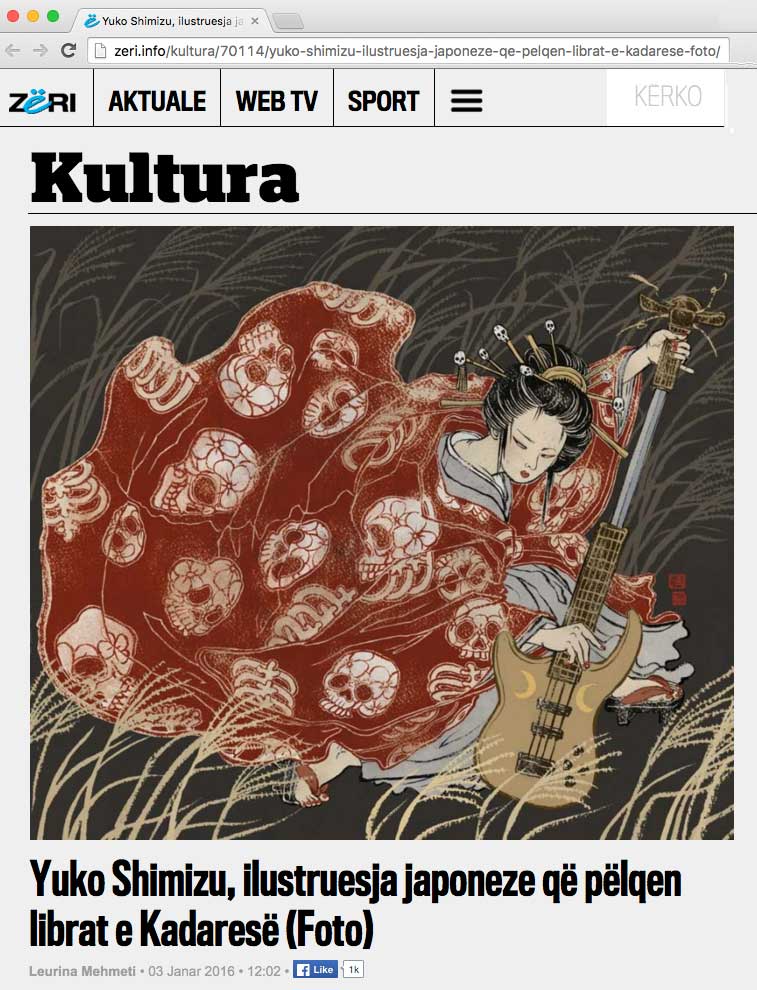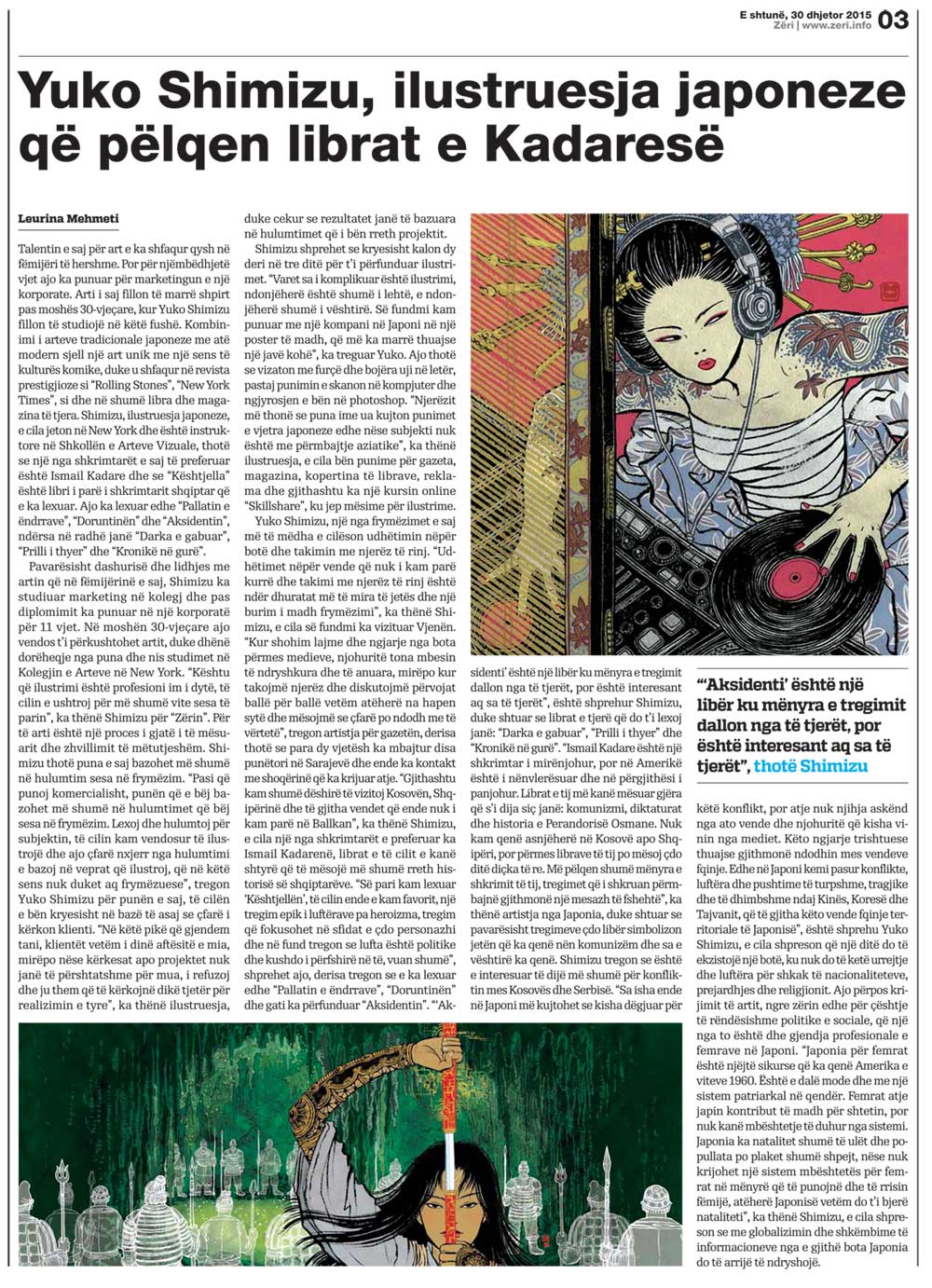Journalist Laurina Mahmeti of Kosovo’s leading newspaper Zëri wrote an article on my work. This is the first time my work was introduced to this part of the world.
If you read Albanian, you can read the whole article online here or the newspaper clipping attached. Also here is the original interview conducted with Laurina on e-mail before the article was written up by her. 
1. Since the kind of art you create is not well known in Kosovo, how would you describe it or how do you call it?
I am an illustrator. I draw pictures for newspapers, magazines, book covers, advertisements, etc, among other things. I draw with ink on paper, then scan that drawing into the computer, and color everything digitally. People tend to say my work reminds them of old Japanese prints, even when subject matter is not Asian. It’s hard to describe my own work, but I guess that is what my work looks like.
2. Since when have you started to draw or make art works and where do you find your inspiration?
I have been drawing ever since I was a small child. However, I did initially take a practical path, studying advertising and marketing in college, and working in corporate PR after graduation. I actually worked in office for quite a while, 11 years to be exact, in Tokyo, Japan where I am originally from. Then I quit, enrolled myself in art college in New York, and studied art for the first time as a 30-some year old adult.
Thus, illustration is my second career, and I have been doing it slightly longer than my previous career.
Since I work commercially, work I make is based on research more so than from inspiration like a fine artist may do. I read and research the subject I will be illustrating. And from full understanding of the topic, I can create artwork to accompany the subject. In that sense, it is not as inspirational.
3. Are there any artists whom you call your idol, mentor or someone whom you have looked up to?
Of course, there are many, especially over the years of my growth as an artist. Right now, I can’t really think of any particular person or people who I call my idols. Funny thing is, once you start making living as an illustrator, anyone whom, up to that point, was your idol and hero suddenly becomes one of your peers. So, that’s when as an artist you have to stop getting direct influence, or obsessively idolize other artists. Otherwise, you will fall into this pitfall of you become someone’s copy, or create works that are too influenced by others.
4. Tell me about the road to your success, accomplishes and all the difficulties you have faced?
I don’t know if I consider myself successful. But yes, if making living creating art is a proof of success, then I guess I am.
Art is a life-long process of learning and getting better, so every day is a challenge, and difficulties. I guess we do what we do, because we love the feeling we get when we finish each and every single difficult task of creating artwork. It’s like asking a mountain-climber why they keep climbing.
5. What makes your art special?
Now, this is something I can’t really answer. I do what I do because of who I am and this is how I do it. How that transfer to artwork that is special is something that the viewers judge.
6. As an illustrator you combine traditional themes with modern ones, how do make this combination and where did this idea come from?
I think I explained in the question #2. The results are all based on thorough research on the subject. The more I know the subject, the better I can come up with the suitable image for it. So, the decisions are not random. If it looks traditional, it calls for the image to be traditional. If the image need to have the modern edge, then it does.
7. If you could tell us about the techniques you use, the colours, brushes and how much time it takes to create an art work?
How much time I spend on each work depends on how complicated the work is, or how smooth the idea comes, or drawing comes, or color comes. Sometimes it is very smooth and easy. Sometimes it’s very hard.
I draw with brush and ink on watercolor paper, and the coloring is done on Photoshop. Sometimes I can start and finish a piece in a day, but as I get more experience, I started to tackle more complicated drawings, so it takes longer now than it used to in past.
Of course, there are deadlines, so I have to somehow meet all the deadlines on my calendar.
Often, I spend about 2-3 days per illustration. Sometimes less, sometimes more. Last week I spent almost a full one week on a big poster I am working with a company in Japan.
9. What do you illustrate mostly?
Whatever it comes my way, whatever a potential clients send me. At this point, clients do know what my strength is, and what I am good at, so the projects tend to be what I am interested in. If projects that is not suitable for me come my way, I say no, and tell them to look for someone else who is more suitable.
10. Since you said that you’re reading a book from an Albanian author, can you please tell us about that author and what you think about the book?
I have been doing Ismail Kadare marathon. I have read 5 of his books so far, in last month or two. I really like his books, and thinking I will keep reading his books continuously for a while. I found one of his books in a bargain bin (sorry!) in a bookstore near my home. I got intrigued, picked it up, and gotten into it.
I have strong interest in learning about former Eastern European countries, especially the Balkans, communism and dictatorships, and the history of Ottoman Empire. So, his books really teach me things I don’t know. Especially I haven’t been to either Albania or Kosovo, so I am learning new things every day by reading his books. I really like how he writes, because they read almost as page-turner, but it always have this secret undercurrent message. Regardless what the actually story is about, each book always symbolize the life under communism and dictatorship and how hard it had been. I also learn about bits and pieces of history of the countries I have never been.
11. You also started to learn a bit about Kosovo, what have you learned till now and what is your opinion about this country?
I was watching a short video about the conflict between Serbia and Kosovo just this morning! (It was mentioned in Kadare’s The Accident (Aksidenti) and it called for understanding of the background history. I do remember about the conflict and civil war, but it was mostly when I was still in Japan and not knowing a single person from the region, it was only what I overheard on the news. These sad histories almost always happens between neighboring countries, and based on the political climate, and not based on how each individual person who live in the area feels. In Japan, we have had some very embarrassing, tragic and sad history and conflict/war/invasion of China, Korea and Taiwan, all of them are Japan’s neighboring countries. I just hope one day, there is a world where there is no longer hate or war, because of nationality, origin or religion…
12. In some posts in your Facebook page, I have seen that you commented about some woman issues in Japan, regarding jobs and art. What is the difference between Japan and America in regard to women’s jobs and artistic goals?
I can talk about this for hours and hours if you let me. Japan for women, I feel like is equivalent of US in the 1960s. It is very old fashioned, male centric society. Though, women do contribute to the work force, there is not enough support system for women to prosper. Japan has some of the world’s lowest birth-rate, and the society is quickly aging. If there is not a good enough social system to support women to both work and raise children, Japan will just keep declining.
I hope this current trend of globalization and information exchange across borders all over the world change Japan quick enough.


